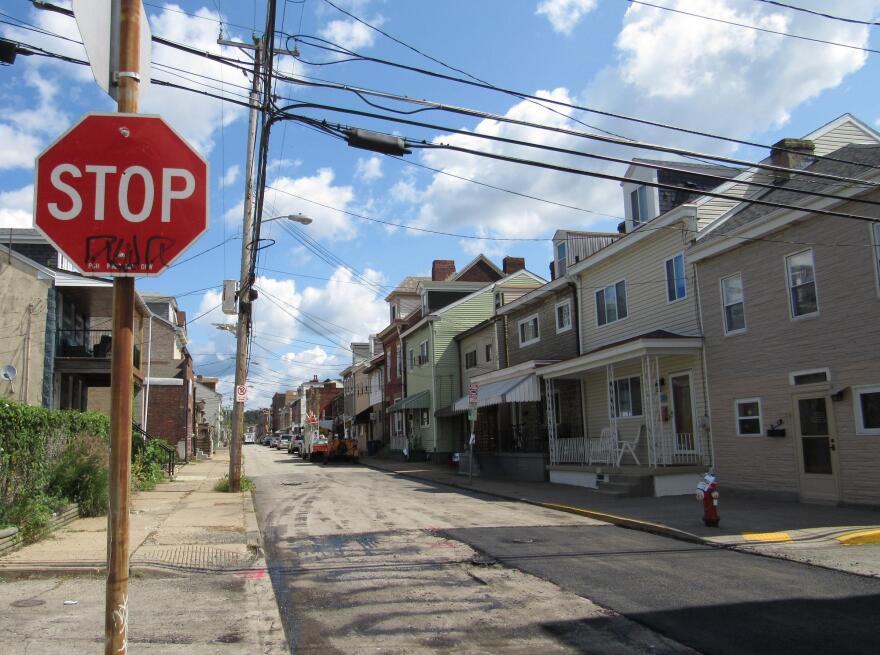It’s an old story: People who live in low-income neighborhoods endure poorer quality of life, with greater health problems, poorer schooling, and worse economic outlooks. And when things do start to look up in those communities, their changing fortunes often result in the displacement of longtime residents who stuck it out when times were tough.
But a new study published by the Brookings Institution suggests there’s another way.
Coauthors Rohit Acharya and Rhett Morris, who lead a research firm called Common Good Labs, studied 3,500 neighborhoods nationwide — including some in the Pittsburgh region — where 30 percent or more of residents live below the federal poverty level. Over a 15-year period, they found that hundreds of communities all across the country got better without losing residents. Acharya’s and Morris’s report asserts that any neighborhood can resist gentrification: if leaders help provide the right conditions.
All the communities Acharya and Morris studied were in urban areas, but in general, they wrote: “It does not matter what region a city is in, nor does it matter if local and state leaders are Democrats or Republicans.”
During the study period, despite two economic downturns, 193 neighborhoods managed to reverse their economic situation without displacing longtime residents. Tapping the potential of machine learning to sort through reams of data, Acharya and Morris discovered that those neighborhoods shared eight key traits, which they divided into external and internal factors.
“We identified the eight indicators as something that, just kind of like a resting heartbeat in health or high cholesterol, it's something that you can track to say, ‘What is the health of this neighborhood?” Acharya explained. “And these are the different factors that really can give you a sense of how this neighborhood is performing over time.”
The three external factors are: positive economic growth in the surrounding metropolitan area, lower homicide rates in the local county, and low risk of displacement from nearby communities. The five internal factors are: higher rates of homeownership, lower residential vacancy rates, increased housing density over time, greater rates of self-employment, and the presence of community-building organizations.
Low-income neighborhoods face more challenges than their wealthier counterparts, but the mix of negative factors can vary greatly, they found, from proximity to toxic release sites to low rates of internet access. The unique situation in any given community requires tailored solutions, but Acharya and Morris note that interventions by federal, state, and local officials as well as philanthropies tend to be one-size-fits-all. For example, federal efforts to address communities in need have taken the shape of providing vouchers for people to move into “high-opportunity” areas.
“When these approaches fail, some leaders find it easier to place blame on poorly served recipients rather than accept responsibility for poorly designed programs … [and] are often used to support the false idea that leaders can’t do anything to change poor neighborhoods,” Acharya and Morris write. “That is clearly wrong.”
Local leaders have tremendous power to change neighborhoods, Morris said in an interview.
“Historically, those changes have been very negative,” he said, citing urban renewal that destroyed neighborhoods to put in highways, banks whose “redlining” lending practices deny loans to Black communities, and industries that built pollution-emitting enterprises nearby.
Conversely, the report says its indicators can be used as “a roadmap” for leaders “who want to see things change in a positive way.”
For example, there’s the indicator that suggests higher rates of entrepreneurship and self-employment can avert displacement – a finding Acharya described as “a welcome surprise.”
“I think there is a belief out there that one of the ways to improve high-poverty neighborhoods is to bring jobs from large organizations,” Acharya said. But the research suggested that when people create businesses in their neighborhoods, “The money [was] staying in the neighborhood and it was driving that neighborhood.”
Morris added that local entrepreneurship may help give people agency, and a way to exercise more control over their environment.
“When they hit tough times, they may have more options,” he said. He added that the businesses which make an impact are not “side hustles,” but substantial enterprises that help people to earn more than the average wage.
In addition, entrepreneurship offers a “pathway to economic mobility for individuals facing discrimination due to their socioeconomic status, race, or ethnicity.”
Acharya and Morris note that local leaders can help create an environment for positive change by supporting small businesses, or providing pathways to increase home ownership.
Acharya and Morris said they talked with leaders in cities across the country, and found that the most common assumption about neighborhoods of concentrated poverty was that it wasn’t possible for them to improve without displacing residents. But “positive change is possible,” Morris said. “This happens all across the country.”
And it’s changed the way that Acharya, who lives in Pittsburgh, and Morris, who lives in Nashville, see the communities where they live. While the report doesn’t cite any particular success stories in Pittsburgh, the region exemplifies much of what the authors set out to investigate. Walking down Penn Avenue or Centre Avenue in Pittsburgh, Acharya said, neighborhoods just blocks from one another have different trajectories.
“Seeing the data about how these different neighborhoods operate and the very different challenges and also opportunities that they offer … it’s made me really appreciate what a network of neighborhoods Pittsburgh is,” he said.
The differences in neighborhoods along the way brings up a central question, Morris said: Why should a community on one side of the street be dramatically different than one on the other side?
“There's nothing [to] dictate that things should be that way,” he said.




